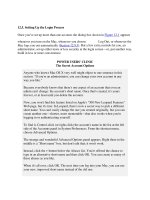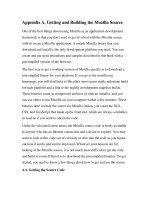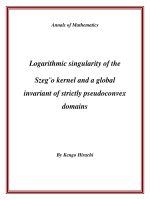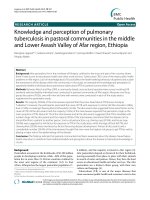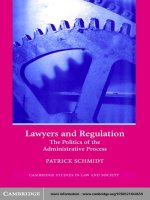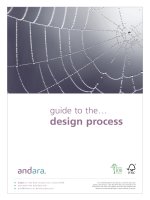LAWYERS AND REGULATION The Politics of the Administrative Process doc
Bạn đang xem bản rút gọn của tài liệu. Xem và tải ngay bản đầy đủ của tài liệu tại đây (10.41 MB, 318 trang )
This page intentionally left blank
This page intentionally left blank
LAWYERS AND REGULATION
The Politics of the Administrative Process
This book is a close study of lawyers who practice occupational safety and
health law in the United States, using detailed interview and survey data
to explore the roles that lawyers have as representatives of companies,
unions, and OSHA (the Occupational Safety and Health Administra-
tion). Placed in the context of evolving understandings of regulatory pol-
itics as a problem of public–private interaction and negotiation, the book
argues that lawyers adapt to multiple roles in what prove to be highly
complex settings. The core chapters examine stages of the administrative
process where various groups attempt to shape the immediate outcomes
and the development of OSHA law. These stages include administrative
rulemaking, post-rulemaking litigation of government standards, regula-
tory enforcement, and compliance counseling by lawyers.
PATRICK SCHMIDT received his B.A. from the University of Min-
nesota (1993) and a Ph.D. from Johns Hopkins University (1999). Prior
to taking up his current post as Assistant Professor of Political Science at
Southern Methodist University, he was the John Adams Research Fellow
at the Centre for Socio-Legal Studies and a research fellow of Nuffield
College, Oxford. He has published widely and is co-editor, with Simon
Halliday, of Human Rights Brought Home: Socio-Legal Studies of Human
Rights in the National Context (2004).
CAMBRIDGE STUDIES IN LAW AND SOCIETY
Cambridge Studies in Law and Society aims to publish the best scholarly
work on legal discourse and practice in its social and institutional con-
texts, combining theoretical insights and empirical research.
The fields that it covers are: studies of law in action; the sociology
of law; the anthropology of law; cultural studies of law, including the
role of legal discourses in social formations; law and economics; law and
politics; and studies of governance. The books consider all forms of legal
discourse across societies, rather than being limited to lawyers’ discourses
alone.
The series editors come from a range of disciplines: academic law;
socio-legal studies; sociology; and anthropology. All have been actively
involved in teaching and writing about law in context.
Series Editors
Chris Arup Victoria University, Melbourne
Martin Chanock La Trobe University, Melbourne
Pat O’Malley Carleton University, Ottawa
Sally Engle Merry Wellesley College, Massachusetts
Susan Silbey Massachusetts Institute of Technology
Books in the Series
The Politics of Truth and Reconciliation in South Africa
Legitimizing the Post-Apartheid State
Richard A. Wilson
0 521 80219 9 hardback
0 521 00194 3 paperback
Modernism and the Grounds of Law
Peter Fitzpatrick
0 521 80222 9 hardback
0 521 00253 2 paperback
Unemployment and Government
Genealogies of the Social
William Walters
0 521 64333 3 hardback
Autonomy and Ethnicity
Negotiating Competing Claims in Multi-Ethnic States
Yash Ghai
0 521 78112 4 hardback
0 521 78642 8 paperback
Constituting Democracy
Law, Globalism and South Africa’s Political Reconstruction
Heinz Klug
0 521 78113 2 hardback
0 521 78643 6 paperback
The New World Trade Organization Agreements
Globalizing Law through Services and Intellectual Property
Christopher Arup
0 521 77355 5 hardback
The Ritual of Rights in Japan
Law, Society, and Health Policy
Eric A. Feldman
0 521 77040 8 hardback
0 521 77964 2 paperback
The Invention of the Passport
Surveillance, Citizenship and the State
John Torpey
0 521 63249 8 hardback
0 521 63493 8 paperback
Governing Morals
ASocial History of Moral Regulation
Alan Hunt
0 521 64071 7 hardback
0 521 64689 8 paperback
The Colonies of Law
Colonialism, Zionism and Law in Early Mandate Palestine
Ronen Shamir
0 521 63183 1 hardback
Law and Nature
David Delaney
0 521 83126 1 hardback
Social Citizenship and Workfare in the United States and
Western Europe
The Paradox of Inclusion
Joel F. Handler
0 521 83370 1 hardback
0 521 54153 0 paperback
Law, Anthropology and the Constitution of the Social
Making Persons and Things
Edited by Alain Pottage and Martha Mundy
0 521 83178 4 hardback
0 521 53945 5 paperback
Judicial Review and Bureaucratic Impact
International and Interdisciplinary Perspectives
Edited by Marc Hertagh and Simon Halliday
0 521 83918 1 hardback
0 521 54786 5 paperback
Immigrants at the Margins
Law, Race, and Exclusion in Southern Europe
Kitty Calavita
0 521 84663 3 hardback
0 521 60912 7 paperback
Lawyers and Regulation
The Politics of the Administrative Process
Patrick Schmidt
0 521 84465 7 hardback
Law and Globalization
from Below
Toward a Cosmopolitan Legality
Edited by Boaventura de Sousa Santos
and Cesar A. Rodriguez-Garavito
0 521 84540 8 hardback
0 521 60735 3 paperback
LAWYERS AND REGULATION
The Politics of the Administrative
Process
Patrick Schmidt
Cambridge, New York, Melbourne, Madrid, Cape Town, Singapore, São Paulo
Cambridge University Press
The Edinburgh Building, Cambridge ,UK
First published in print format
- ----
- ----
© Patrick Schmidt 2005
2005
Information on this title: www.cambrid
g
e.or
g
/9780521844659
This book is in copyright. Subject to statutory exception and to the provision of
relevant collective licensing agreements, no reproduction of any part may take place
without the written permission of Cambridge University Press.
- ---
- ---
Cambridge University Press has no responsibility for the persistence or accuracy of
s for external or third-party internet websites referred to in this book, and does not
guarantee that any content on such websites is, or will remain, accurate or appropriate.
Published in the United States of America by Cambridge University Press, New York
www.cambridge.org
hardback
eBook (EBL)
eBook (EBL)
hardback
For my father and grandfather
Contents
List of figures and tables page xii
Table of cases xiv
Acknowledgments xvi
List of abbreviations xviii
1Introduction 1
2The contours of a regulatory bar 29
3Administrative rulemaking 54
4 Rulemaking litigation 96
5 Enforcement 137
6Regulatory counseling 186
7Conclusion 210
Appendix 1 Research methods 223
Appendix 2 Survey instrument 229
Notes 240
Bibliography 273
Index 291
xi
FIGURES AND TABLES
FIGURES
2.1 The pyramidal organization of the OSHA bar page 32
3.1 Source of comment letters for twenty-five rules
completed 1990–7 60
3.2 Length of OSHA final rule documents in the
Federal Register,moving five-year medians and
means, 1972–2002 84
TABLES
2.1 Percentage of surveyed attorneys’ practices devoted
to OSHA work 33
2.2 Areas of specialization, all respondents 36
2.3 Distribution of attorneys’ time within their OSHA
practices 37
2.4 Fora engaged in by OSHA attorneys in past five years 39
2.5 Leading geographic concentrations for OSHA-related
lawyers 42
2.6 Firm sizes and specialization 43
2.7 Demographics – OSHA bar and comparison groups 46
2.8 Political party affiliation of OSHA practitioners 48
2.9 Leading law schools of OSHA practitioners 49
2.10 Law school ranking of OSHA practitioners 50
2.11 Government experience of OSHA practitioners 51
xii
LIST OF FIGURES AND TABLES
3.1 Advocacy of company rulemaking participation 62
3.2 Forms of attorney participation in OSHA rulemaking 66
4.1 Leading objectives in OSHA rulemaking suits 98
4.2 Chronology of major events in OSHA’s lockout/tagout
rulemaking 113
5.1 Total OSHA inspections, citations, and penalties
by type of firm and number of employees, FY 1997,
versus OSHA bar’s clientele 147
5.2 Average initial penalties assessed in attorneys’ cases 148
5.3 Stage of attorneys’ entry into OSHA cases 149
5.4 Attorneys’ preferences for strategic OSHA inspection
decisions 162
5.5 Client knowledge of attorneys’ styles 165
5.6 Important concerns in attorney–client discussions
about OSHA enforcement 172
5.7 Stage of attorneys’ resolution of OSHA cases 173
6.1 Most common counseling issues encountered
by OSHA counsel 192
6.2 Most common means of compliance assistance
by OSHA attorneys in the past twelve months 198
7.1 Partial typology of influences in OSHA regulatory
interactions 213
7.2 Roles of lawyers as interest representatives 215
A1.1 Primary background of interviewees about OSHA
regulation 225
A1.2Responseratebynumberofsourcesidentifyingthe
attorney, and comparative attributes of sub-samples 227
xiii
CASES
AFL-CIO v. Marshall, 617 F.2d 636 (D.C. Cir. 1979) page 77–8
AFL-CIO v. OSHA, 965 F.2d 962 (11th Cir. 1992) 111
American Iron & Steel Institute v. OSHA, 577 F.2d
825 (3d Cir. 1978) 78,252n.29
American Textile Manufacturers Institute, Inc. v.
Donovan, 452 U.S. 490 (1981) 76,122
Asbestos Information Association v. OSHA,
727 F.2d 415 (5th Cir. 1984) 252n.27
Asbestos Information Association v. Reich,
117 F.3d 891 (5th Cir. 1997) 109–10
Associated Industries of NY State v. Department
of Labor, 487 F.2d 342 (2d Cir. 1973) 82,253n.39
Color Pigments Manufacturers Association v. OSHA,
16 F.3d 1157 (11th Cir. 1994) 77,252n.27
Cuyahoga Valley Railway v. United Transportation
Union, 474 U.S. 3 (1985) 264n.29
Dole v. United Steelworkers of America, 494 U.S.
26 (1990) 261n.85
Dry Color Manufacturers Association v. Department
of Labor, 486 F.2d 98 (3d Cir. 1973) 82,253n.39
Edison Electric Institute v. OSHA, 849 F.2d 611
(D.C. Cir. 1988) 257n.38
Fire Equipment Manufacturers Association v. Marshall,
679 F.2d 679 (7th Cir. 1982) 255n.7
xiv
TABLE OF CASES
Hern Iron Works, Inc. v. Donovan, 670 F.2d 838
(9th Cir. 1982) 145,264n.35
Industrial Union Department, AFL-CIO v.
American Petroleum Institute,
448 U.S. 607 (1980) 76,123,251n.25
International Union, UAW v. OSHA, 938
F.2d1310(D.C.Cir1991)121–2, 258n.52
International Union, UAW v. OSHA, 976 F.2d 749
(D.C. Cir. 1992) 123
International Union, UAW v. OSHA, 37 F.3d 665
(D.C. Cir. 1994) 123–4,252n.26
International Union, UAW v. Pendergrass, 878
F.2d 389 (D.C. Cir. 1989) 131–2
Marshall v. Barlow’s, Inc., 436 U.S. 307 (1978) 139
Martin, Secretary of Labor v. OSHRC, 499 U.S. 144
(1991) 143–4
Reich v. Arcadian Corporation, 110 F.3d 1192
(5th Cir. 1997) 267n.65
Secretary of Labor v. Bethlehem Steel Corp., 9 OSHC
2177 (1981) 270n.29
Secretary of Labor v. Boise Cascade Corp., 14 OSHC
1993 (1991) 144,264n.28
Secretary of Labor v. Dayton Tire, 16 OSHC 1961
(1994) 178,267n.79
Secretary of Labor v. Ho, OSHRC No. 98-1645,
98-1646 (OSHRC, Sept. 29, 2003) 168,267n.66
Secretary of Labor v. Oscar Renda Contracting,
Inc., 17 OSHC 1883 (1997) 263n.21
Steel Joist Institute v. OSHA, 287 F.3d 1165 (D.C.
Cir. 2002) 128,260n.76
Synthetic Organic Chemical Manufacturers
Association v. OSHA, 503 F.2d 1155 (3d Cir. 1974) 78,252n.29
United Steelworkers v. Marshall, 592 F.2d 693
(3d Cir. 1979) 108–9
xv
ACKNOWLEDGMENTS
Many people deserve my thanks for their contributions, large and small,
to this book. Woody Howard and Joel Grossman were meticulous and
inspiring in the early stages of this project, and no young scholar could
hope to find a better pair of mentors. Despite his protests to the con-
trary, very little of this book or my career would have been possible
without David Yalof’s direction, professional and otherwise. The sup-
port of many institutions and the people in them deserves mention:
the Department of Political Science at Johns Hopkins University; the
Centre for Socio-Legal Studies and Nuffield College at the Univer-
sity of Oxford; and the Department of Political Science at Southern
Methodist University have all provided comfortable homes, supportive
environments, and generous support for my work. Finola O’Sullivan,
Jane O’Regan, Brenda Burke, and Diane Ilott at Cambridge Univer-
sity Press were supportive and tireless through the whole process. The
anonymous reviewers and series editors offered excellent direction. I
have long ago lost track of the names of librarians here, there, and
everywhere who went the extra step. Numerous colleagues and friends
have also given direct support to some aspect of this project. With
my apologies to those inadvertently left off, I would like to recognize:
Pamela Winston, Margie Brassil, Doug Dow, Doreen McBarnet, Simon
Halliday, Denis Galligan, Philip Lewis, Alec Stone Sweet, Liz Fisher,
Paul Martin, Bronwen Morgan, Joe Kobylka, and Dennis Simon.
Others have provided indirect support, which has been no less mean-
ingful and always deeply appreciated. I am confident that Eric Doherty
xvi
ACKNOWLEDGMENTS
has provided direct support at some point in the past, but if he didn’t
he certainly leads the class in this latter category.
The lawyers and other organizational representatives whose anony-
mous voices are heard in this book graciously welcomed me into their
offices. Time is money, and thankfully I have yet to see a single bill for
the many hours of time – collectively valued in the tens of thousands
of dollars – that was given to this research.
Words can acknowledge but never sufficiently capture my fam-
ily’s contribution. When deadlines required it, my sister, Liz Jennings,
eagerly and expertly helped with the final editing details, for which I am
most grateful. My in-laws, Gerry and Tim Moore, have often provided
acomputer in their laundry room that has been a productive sanctuary.
I have never doubted the love and support at all levels from my parents
and grandparents, and that has lifted me higher than I could ever hope
to go on my own. My children, Ailsa and Aidan, provide the hope that
drives each day. Most of all, Lea Anne has supported me unfailingly
while bearing the brunt of everything that goes along with being mar-
ried to an academic. In the rest of our lives together I don’t think I can
hope to repay, except in love, the debt I have already accumulated.
Portions of this book have appeared in other forms:
“Pursuing Regulatory Relief: Strategic Participation and Litigation in
U.S. OSHA Rulemaking” by Patrick Schmidt first appeared in print
in Business and Politics vol 4 pp. 71–89 (Taylor & Francis, 2002)
and remains available in an Online
Version with the Berkeley Electronic Press: Vol. 4: No. 1, Article 3
/>Patrick Schmidt (2004), “Law in the Age of Governance: Regula-
tion, Networks and Lawyers”, in Jacint Jordana and David Levi-Faur
(eds), The Politics of Regulation, Chapter 12 (Cheltenham, UK and
Northampton, MA, USA: Edward Elgar) pp 296–319.
xvii
ABBREVIATIONS
ABA American Bar Association
ACC American Chemistry Council
ACGIH American Council of Government Industrial Hygienists
AISI American Iron and Steel Institute
ALJ Administrative Law Judge
ANPR Advance Notice of Proposed Rulemaking
APA Administrative Procedure Act
API American Petroleum Institute
CMA Chemical Manufacturers Association (now American
Chemistry Council)
DOL Department of Labor
EEI Edison Electric Institute
EPA Environmental Protection Agency
ETS Emergency Temporary Standard
FCC Federal Communications Commission
FY Fiscal Year
IBEW International Brotherhood of Electrical Workers
GAO Government Accountability Office (formerly General
Accounting Office)
LIA Lead Industries Association
MSHA Mine Safety and Health Administration
NAM National Association of Manufacturers
NAPA National Asphalt Pavement Association
NESC National Electrical Safety Code
NIOSH National Institute for Occupational Safety and Health
xviii
LIST OF ABBREVIATIONS
NLRB National Labor Relations Board
NPRM Notice of Proposed Rulemaking
OCAW Oil, Chemical, and Atomic Workers
OMB Office of Management and Budget
OSHA Occupational Safety and Health Administration
OSHRC Occupational Safety and Health Review Commission
PEL Permissible Exposure Limit
PRMA Paint Remover Manufacturers Association
SOL Solicitor of Labor
UAW United Auto Workers
xix
CHAPTER ONE
INTRODUCTION
The late Clark Clifford, advisor to US Presidents and legendary Wash-
ington attorney, was famed for warning new clients interested in legal
representation before the executive branch and its agencies that he
had no “influence.”
1
Clifford claimed only to possess the expertise of
someone intimately familiar with the workings of the US government,
which allowed him to instruct clients on how best to place their views
and needs before administrative agencies and executive branch depart-
ments. Clifford’s caveat has struck many as implausible, even ridicu-
lous, because he clearly offered more than sound legal argumentation: a
wealth of “insider” contacts with government officials at all levels, and
a reputation that preceded him.
Whatever the real source of his influence – perhaps sui generis –
Clifford’s legacy still clouds our understanding of how lawyers conduct
the practice of law before administrative agencies. Indeed, both aca-
demics and journalists in search of Clifford’s contemporary equivalents
seem to hold the notion that if regulatory lawyers are not the equiv-
alent of lobbyists “moving and shaking” the government on behalf of
corporate interests, then they are merely technicians of the law with-
out an appreciable impact on administrative politics. The simplicity of
these visions is understandable, not least because if the advocacy made
by lawyers is not presented with the color and force of a lobbyist, then
it is made in arcane legalisms typically understood and appreciated only
by lawyers.
Regulatory systems are pervasive in modern society. They are
tools with which political systems have found mechanisms, both of
1
LAWYERS AND REGULATION
convenience and of necessity, for the propagation and implementa-
tion of rules. Like the portrait of regulatory lawyers, the contemporary
administrative state rests on foundations in tension, between ideals of
a free-ranging policy process and a process encumbered by mechanisms
of accountability. The most distinguishing feature of regulatory systems
is the necessity of discretion – political choice – infused throughout the
administrative state.
2
The expansion of bureaucratic processes, perhaps
the most profound alteration to the political landscape in the twentieth
century, has generated awareness of both the importance and potential
problems of discretion. While administrative policymaking often sup-
plements or even supplants legislative decisionmaking, a democratic
“deficit” results from weaker mechanisms of accountability in prac-
tice. As faith in the expertise of administrators waned in the twentieth
century, the emphasis on processes sometimes stood in as one solution
to this deficit. In the United States, in particular, the drive to procedu-
ralize the administrative state only generated new concerns about the
effects of legalization and judicialization in a system with interest rep-
resentation at its heart.
Because of the particular foundations, evolution, and culture in the
American context, lawyers are basic ingredients in the contemporary
regulatory soup as representatives of private interests. Given concerns
about the influence of private power on public administration, a general
accounting of how bureaucracy translates legislative goals into con-
crete results simply cannot ignore what lawyers provide as intermedi-
aries. Still, despite substantial attention to the process of governance
from both lawyer and nonlawyer commentators, very little systematic
attention has been paid to the behavior of lawyers in regulatory set-
tings. The unexamined questions at the juncture between lawyers and
regulation are many and basic: What do attorneys do for their clients?
How do attorneys perceive their role in administrative settings and how
do these perceptions affect their dialogues with clients? In what ways
do the activities of lawyers shape – and how are they shaped by – the
agencies they encounter? Perhaps most fundamentally, how do the con-
tributions of lawyers qua lawyers, with everything that implies for the
role of law, construct the politics of the administrative process?
These questions lie at the intersection of two key themes featured in
debates about contemporary administrative governance: how regula-
tory agencies bargain and dispute with private interests over the cre-
ation and application of general rules; and, more centrally, the roles
representatives of interests, specifically lawyers, play in these processes.
2
INTRODUCTION
Enormous variation across and within national systems of social and
economic regulation fractures our understanding of interest represen-
tation, but from this kaleidoscope emerges a pattern of concern regard-
ing the influence and power of private interests. Individuals who repre-
sent public and private interests are positioned to shape the distribution
of wealth and welfare, and through their actions, to give rise to wider
structures of political advantage. Of course, the position of lawyers in
America may be unrivaled and uniquely placed in popular discourse.
3
Elsewhere, various professional groups or non-professional representa-
tives may dominate regulatory politics. Nevertheless, at the heart of this
book are questions about how a state journeys from legislative man-
dates to applications of law in practice, with a fundamental tension,
every step of the way, between choices of interest and values, on the
one hand, and the desire for process on the other.
This study brings together concern for the administrative process
and the role of lawyers by focusing on the roles, strategies, and atti-
tudes of attorneys practicing before the US Occupational Safety and
Health Administration (OSHA). Established in 1970 and charged with
improving and maintaining the safety and health of workplaces in the
United States, OSHA’s history contains all the hopes, controversies,
successes, and failures one could ever wish on a regulatory bureau-
cracy. As a leading example of a “social regulatory” agency created
in a wave during the 1960s and 1970s, its organization contains the
two distinct processes – administrative rulemaking and enforcement –
that are often considered separately but less commonly are considered
together. Though different agencies, even different processes within an
agency, might be seen as unique occasions for legal work, the shared
endeavor across the OSHA policy process applies beyond the US as
well: how should the state, both produced by and interacting with the
private sphere, transform abstract policy goals into specific commands
and incentives? This is not to limit administration to a “top-down”
process. Rather, in the gap between the text of a statute and the behav-
ior of an individual regulated entity, every step of the regulatory process
can become a site for interpretation and contestation of what the law
means. Selection and design of administrative processes shapes result-
ing politics and policy, but viewed from a distance, rulemaking and
enforcement unite in the common goal of putting flesh on skeletal pol-
icy and giving life to law, though they remain important guideposts to
where lawyers may become involved. This frame of reference begins
to highlight the complex setting for a regulatory bar, defined simply as
3


